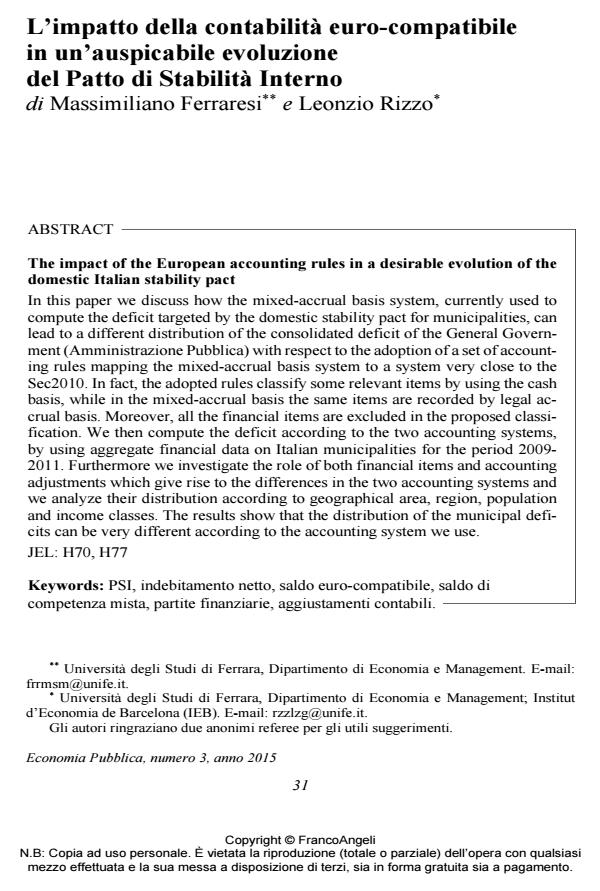The impact of the European accounting rules in a desirable evolution of the domestic Italian stability pact
Journal title ECONOMIA PUBBLICA
Author/s Massimiliano Ferraresi, Leonzio Rizzo
Publishing Year 2016 Issue 2015/3 Language Italian
Pages 27 P. 31-57 File size 287 KB
DOI 10.3280/EP2015-003002
DOI is like a bar code for intellectual property: to have more infomation
click here
Below, you can see the article first page
If you want to buy this article in PDF format, you can do it, following the instructions to buy download credits

FrancoAngeli is member of Publishers International Linking Association, Inc (PILA), a not-for-profit association which run the CrossRef service enabling links to and from online scholarly content.
In this paper we discuss how the mixed-accrual basis system, currently used tocompute the deficit targeted by the domestic stability pact for municipalities, canlead to a different distribution of the consolidated deficit of the General Government(Amministrazione Pubblica) with respect to the adoption of a set of accountingrules mapping the mixed-accrual basis system to a system very close to theSec2010. In fact, the adopted rules classify some relevant items by using the cashbasis, while in the mixed-accrual basis the same items are recorded by legal accrualbasis. Moreover, all the financial items are excluded in the proposed classification.We then compute the deficit according to the two accounting systems,by using aggregate financial data on Italian municipalities for the period 2009-2011. Furthermore we investigate the role of both financial items and accountingadjustments which give rise to the differences in the two accounting systems andwe analyze their distribution according to geographical area, region, populationand income classes. The results show that the distribution of the municipal deficitscan be very different according to the accounting system we use.
Keywords: domestic stability pact; deficit; European accounting rules; internal accounting rules; financial items; accounting adjustments
- Agenzia delle entrate (2015). Gli immobili in Italia. Testo disponibile al sito: http://www.agenziaentrate.gov.it
- Baldini M., Toso S. (2009). Diseguaglianza, povertà e politiche pubbliche. Bologna: il Mulino.
- Banca d’Italia (2008). Household Wealth in Italy. Papers presented at the Conference held in Perugia, 16-17 October 2007.
- Banca d’Italia (2013a). Relazione annuale.
- Banca d’Italia (2013b). La ricchezza delle famiglie italiane. Supplemento al Bollettino Statistico No 65.
- Banca d’Italia (2014). I bilanci delle famiglie italiane nell’anno 2012. Supplemento al Bollettino Statistico No 5.
- Bises B., Scialà A. (2014). The Taxation of the Owner-Occupied House in Italy: 1974-2014. Public Finance Research Paper No 7.
- Bosi, P., Guerra M.C. (2014). I tributi nell’economia italiana. Bologna: il Mulino.
- Buchanan, J. (1967). Public Finance in Democratic Process; Fiscal Institutions and the Individual Choice. Chapel Hill: University of North Carolina Press.
- Cabral, M., Hoxby C. (2012). The Hated Property Tax: Salience, Tax Rates, and Tax Revolts, NBER Working Paper No 18514.
- Cannari L., Faiella I. (2008). House prices and housing wealth in Italy. In: Household Wealth in Italy, Banca d’Italia.
- Commissione europea (2014). Taxation Trends in the European Union.
- Creedy J. (2003). Survey Reweighting for Tax Microsimulation Modelling. New Zealand Treasury Working Paper Series No 18.
- Fischel W.A. (2001). The Homevoter Hypothesis. Cambridge, MA: Harvard University Press.
- Kakwani N.C. (1977). Measurement of Tax Progressivity: An International Comparison. Economic Journal, 87: 71-80. DOI: 10.2307/2231833
- Lambert P.J. (2001). The distribution and redistribution of income. Manchester: Manchester University Press.
- Liberati P. (2011). Which Tax or Which Tax for What?: Tax Assignment in the Theory of Fiscal Federalism. Public Finance Review, 39(3): 365-392. DOI: 10.1177/1091142110381637
- Mirrlees J. (2011). Tax by design: The Mirrlees review. Oxford: Oxford University Press.
- Musgrave R. (1959). The Theory of Public Finance: A Study of Public Economics. New York: McGraw-Hill.
- Musgrave R. (1983). Who should Tax, Where and What? In: McLure C.E. (Ed.). Tax Assignment in Federal Countries. Canberra: Australian National University Press.
- Norregaard J. (2013). Taxing Immovable Property. Revenue Potential and Implementation Challenges. IMF Working Paper No. 129.
- Oates W.E. (1969). The Effects of Property Taxes and Local Public Spending on Property Values: an Empirical Study of Tax Capitalization and the Tiebout Hypothesis. Journal of Political Economy, 77: 957-971. DOI: 10.1086/259584
- Oates W.E. (2005). Property Taxation and Local Public Spending: The Renter Effect. Journal of Urban economics, 57: 419-431. DOI: 10.1016/j.jue.2004.12.006
- OECD (2014). World Economic Outlook.
- Pacifico D. (2014). Sreweight: A Stata Command to Reweight Survey data to External Totals. Stata Journal, 14(1): 4-21.
- Pellegrino S. (2007). L’Ici: una valutazione ad un decennio dalla sua introduzione. Economia Pubblica, 5-6: 143-170.
- Pellegrino S., Piacenza M., Turati G. (2012). Assessing the Distributional Effects of Housing Taxation in Italy: A Microsimulation Approach, CESifo Economic Studies, 58(3): 495-524.
- Piketty T. (2014). Capital in the Twenty-first Century. Harvard: Harvard University Press.
- Puviani A. (1903). Teoria dell’illusione finanziaria. Ed. 1973, a cura di F. Volpi. Milano: Isedi.
- Rosengard J.K. (2012). The Tax Everyone Loves to Hate: Principles of Property Tax Reform. Harvard Kennedy School Working Paper No 10.
Massimiliano Ferraresi, Leonzio Rizzo, L’impatto della contabilità euro-compatibile in un’auspicabile evoluzione del patto di stabilità interno in "ECONOMIA PUBBLICA " 3/2015, pp 31-57, DOI: 10.3280/EP2015-003002